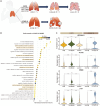Dynamics of T Cell-Mediated Immune Signaling Network During Pathogenesis of Chronic Obstructive Pulmonary Disease
- PMID: 40414827
- PMCID: PMC12116870
- DOI: 10.3349/ymj.2024.0227
Dynamics of T Cell-Mediated Immune Signaling Network During Pathogenesis of Chronic Obstructive Pulmonary Disease
Abstract
Purpose: Chronic obstructive pulmonary disease (COPD) is characterized by alveolar destruction and increased inflammation, leading to respiratory symptoms. This study aimed to identify the traits for COPD progression from mild to severe stages. Additionally, we explored the correlation between coronavirus disease-2019 (COVID-19) and COPD to uncover overlapping respiratory patterns.
Materials and methods: Bulk RNA sequencing was conducted on data from 43 healthy individuals and 39 COPD patients across one dataset (GSE239897) to distinguish COPD characteristics. Single-cell RNA analysis was then performed on samples from seven mild patients, seven moderate patients, and three severe patients from three datasets (GSE167295, GSE173896, and GSE227691) to analyze disease progression. Finally, single-nuclei RNA analysis was applied to data from seven healthy individuals and 20 COVID-19 patients from one dataset (GSE171524) to compare the two conditions.
Results: Bulk RNA sequencing revealed enhanced inflammatory pathways in COPD patients, indicating increased inflammation. Single-cell RNA sequencing showed a stronger inflammatory response from mild to moderate COPD with a decrease from moderate to severe stages. COVID-19 displayed similar biological patterns to moderate COPD, suggesting that stage-specific COPD analysis could enhance COVID-19 management.
Conclusion: The analysis found that immune responses increased from mild to moderate stages but declined in severe cases, marked by reduced pulmonary T cell activation. The overlap between moderate COPD and COVID-19 suggests shared therapeutic strategies, warranting further investigation.
Keywords: COVID-19; Chronic obstructive pulmonary disease; single-cell RNA sequencing.
© Copyright: Yonsei University College of Medicine 2025.
Conflict of interest statement
The authors have no potential conflicts of interest to disclose.
Figures





Similar articles
-
Increased SARS-CoV-2 Infection, Protease, and Inflammatory Responses in Chronic Obstructive Pulmonary Disease Primary Bronchial Epithelial Cells Defined with Single-Cell RNA Sequencing.Am J Respir Crit Care Med. 2022 Sep 15;206(6):712-729. doi: 10.1164/rccm.202108-1901OC. Am J Respir Crit Care Med. 2022. PMID: 35549656 Free PMC article.
-
Integrating bulk and single-cell RNA sequencing data: unveiling RNA methylation and autophagy-related signatures in chronic obstructive pulmonary disease patients.Sci Rep. 2025 Feb 1;15(1):4005. doi: 10.1038/s41598-025-87437-2. Sci Rep. 2025. PMID: 39893187 Free PMC article.
-
Identification of novel biomarkers related to neutrophilic inflammation in COPD.Front Immunol. 2024 May 30;15:1410158. doi: 10.3389/fimmu.2024.1410158. eCollection 2024. Front Immunol. 2024. PMID: 38873611 Free PMC article.
-
Global Initiative for the Diagnosis, Management, and Prevention of Chronic Obstructive Lung Disease. The 2020 GOLD Science Committee Report on COVID-19 and Chronic Obstructive Pulmonary Disease.Am J Respir Crit Care Med. 2021 Jan 1;203(1):24-36. doi: 10.1164/rccm.202009-3533SO. Am J Respir Crit Care Med. 2021. PMID: 33146552 Free PMC article. Review.
-
Advances on the Role of Lung Macrophages in the Pathogenesis of Chronic Obstructive Pulmonary Disease in the Era of Single-Cell Genomics.Int J Med Sci. 2025 Jan 1;22(2):298-308. doi: 10.7150/ijms.100160. eCollection 2025. Int J Med Sci. 2025. PMID: 39781522 Free PMC article. Review.
References
MeSH terms
Grants and funding
LinkOut - more resources
Full Text Sources
Medical

